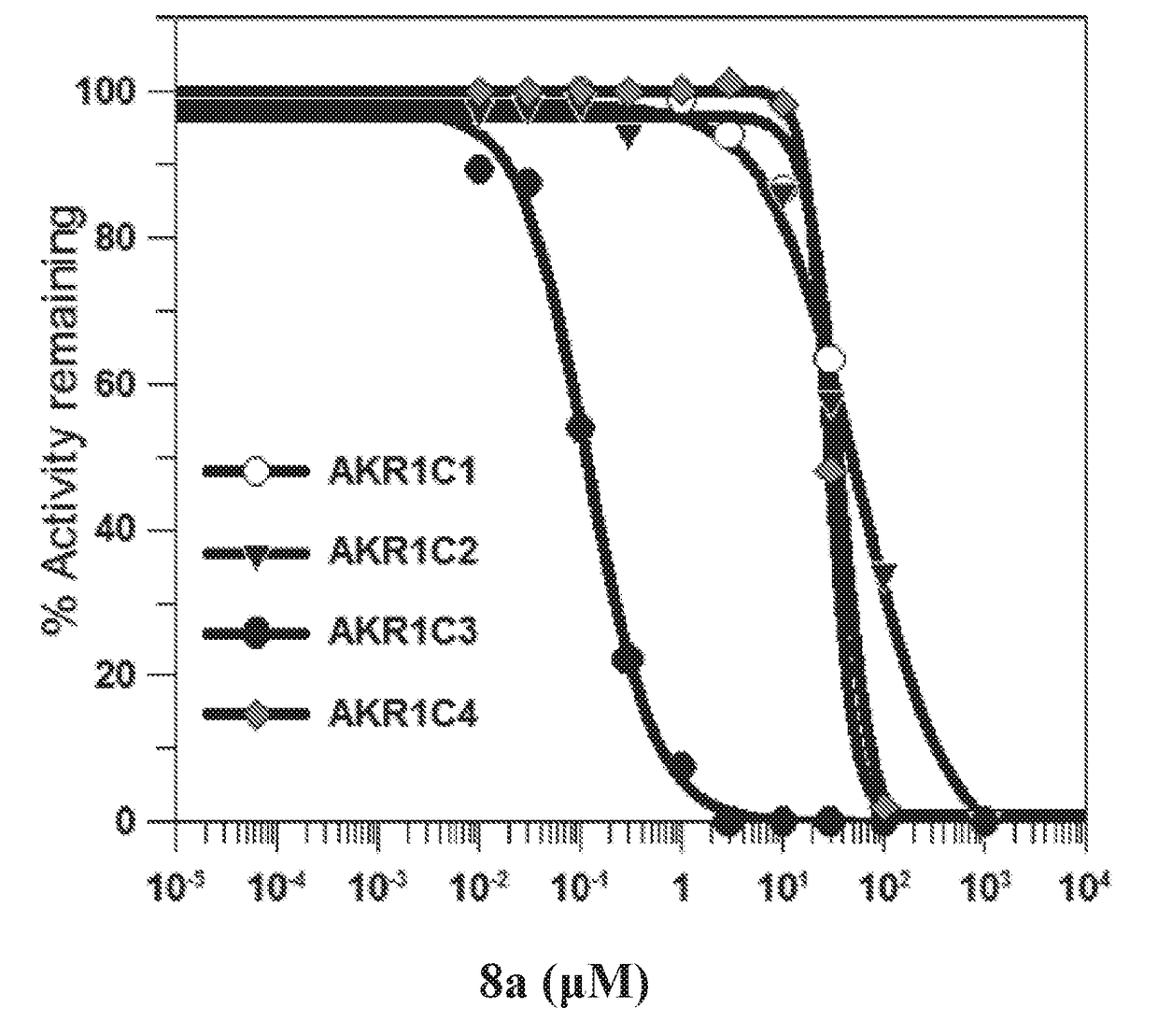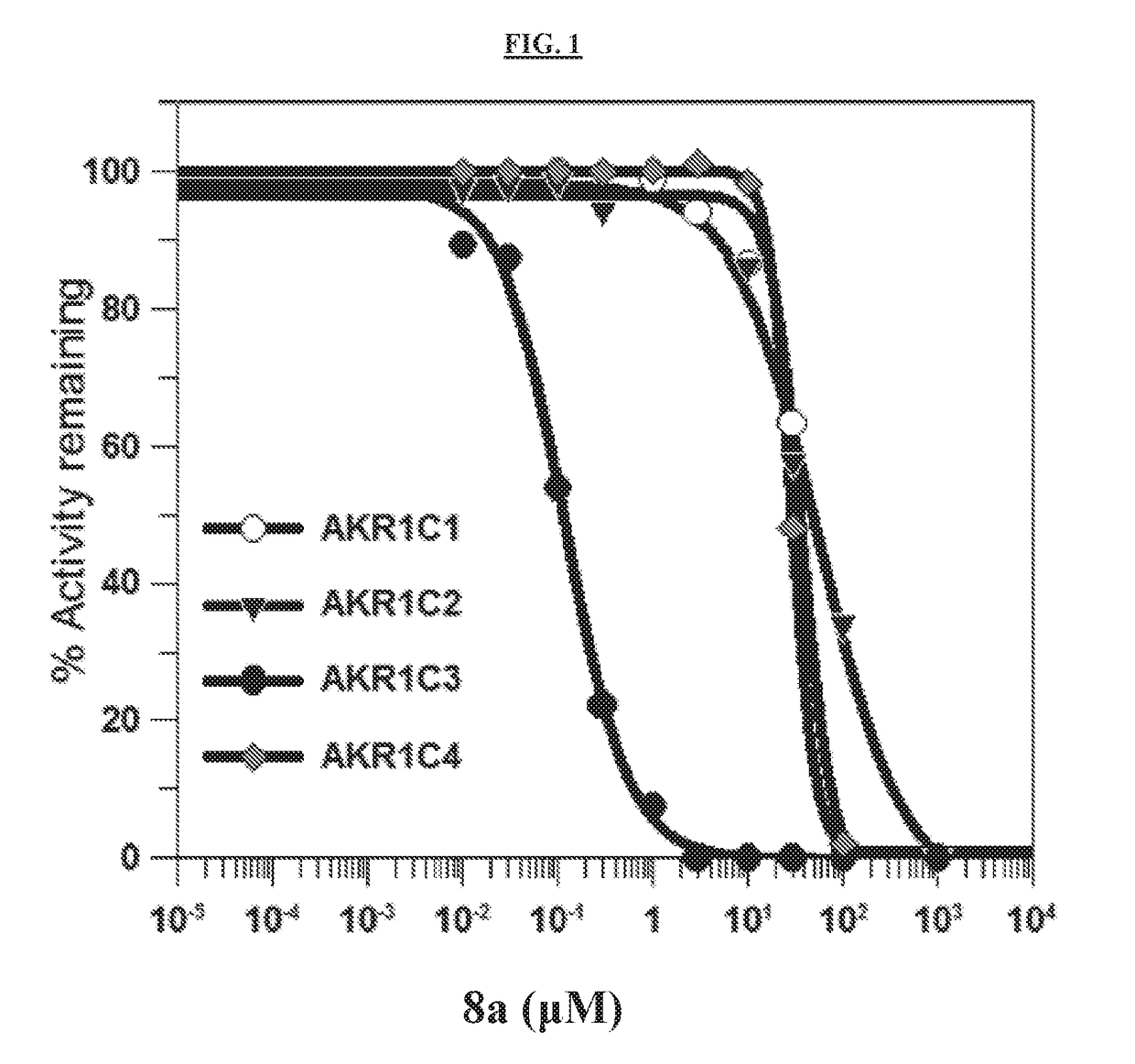2-beta-naphthyl-acetic acid analogs as akr1c3 inhibitors and methods of using same
a technology of acetic acid analogs and beta-naphthyl-acetic acid, which is applied in the field of 2beta-naphthyl-acetic acid analogs as, can solve the problems of compound drug resistance, limiting the therapeutic potential of crpc, and leading causes of cancer incidence and death worldwid
- Summary
- Abstract
- Description
- Claims
- Application Information
AI Technical Summary
Benefits of technology
Problems solved by technology
Method used
Image
Examples
example 1
d AKR1C2 Inhibitor Screening
[0279]Naproxen analogs were synthesized to explore the effect of modifications of its structure on AKR1C3 activity and selectivity. Certain synthesized compounds were carboxylic acids. Modifications were made primarily on the α-carbon or the 6-position of the naphthalene ring. Due to the presence of the chiral center in the molecule, most of compounds (compounds 2-8) were initially assayed as racemates and screened for AKR1C2 and AKR1C3 inhibition without separation of the enantiomers.
[0280]S-Naproxen 1 was the precursor of certain compounds disclosed herein (Schemes 1-2). A common intermediate was S-methyl-2-(6-trifluoromethylsulfonyloxy naphthalene propanoate (D). This compound was synthesized from S-naproxen, which was converted to O-demethyl naproxen (B) under acidic conditions followed by esterification to yield C. Subsequent addition of trifluoromethane sulfonic anhydride in base gave D. Compound D was converted to compound E (compound 2) via the 6-...
example 2
8a on AKR1C2 Catalyzed Reduction of 5α-DHT
[0287]Compound 8a and 8b were next evaluated for the ability to inhibit AKR1C2 catalyzed NADPH dependent reduction of 5α-DHT (AKR1C2's physiologically relevant steroidal substrate). In this reaction, compound 8b inhibited AKR1C2 in a dose dependent manner over the concentration range of 3-100 μM achieving 70% inhibition of enzyme activity at 100 M (FIG. 2). In contrast, 8a did not display any significant inhibition of AKR1C2 at <100 μM concentrations. Flufenamic acid (FLU), a non-selective inhibitor of the AKR1C enzymes, displayed about 70% inhibition of AKR1C2 at 10 μM concentration.
example 3
KR1C3 Inhibition by 8a
[0288]The pattern of AKR1C3 inhibition by 8a was evaluated by measuring the NADP+ dependent oxidation of S-tetralol and by measuring the NADPH dependent reduction of Δ4-androsten-3,17-dione. Compound 8a competitively inhibited the AKR1C3 catalyzed oxidation of S-tetralol with a Ki value of 31 nM (FIG. 3A). The same mode of inhibition was also observed when the reduction of Δ4-AD was monitored, albeit with a much higher Ki value of 750 nM (FIG. 3B).
PUM
| Property | Measurement | Unit |
|---|---|---|
| Molar density | aaaaa | aaaaa |
| Molar density | aaaaa | aaaaa |
| Molar density | aaaaa | aaaaa |
Abstract
Description
Claims
Application Information
 Login to View More
Login to View More - R&D
- Intellectual Property
- Life Sciences
- Materials
- Tech Scout
- Unparalleled Data Quality
- Higher Quality Content
- 60% Fewer Hallucinations
Browse by: Latest US Patents, China's latest patents, Technical Efficacy Thesaurus, Application Domain, Technology Topic, Popular Technical Reports.
© 2025 PatSnap. All rights reserved.Legal|Privacy policy|Modern Slavery Act Transparency Statement|Sitemap|About US| Contact US: help@patsnap.com



